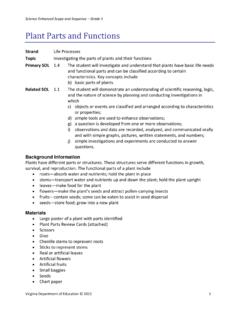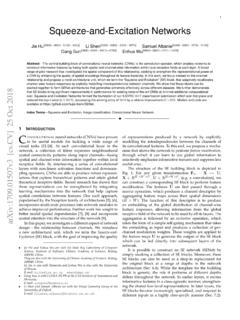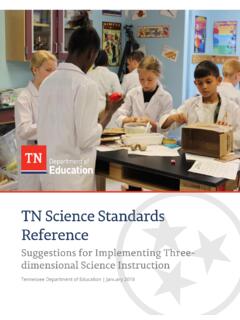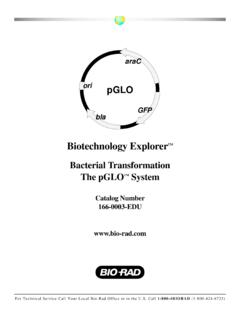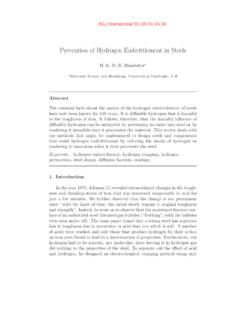Transcription of IEEE TRANSACTIONS ON KNOWLEDGE AND DATA …
1 IEEE TRANSACTIONS ON KNOWLEDGE AND DATA ENGINEERING1A Survey on Accuracy-oriented NeuralRecommendation: From Collaborative Filteringto Information-rich RecommendationLe WuMember, IEEE, Xiangnan HeMember, IEEE, Xiang WangMember, IEEE,Kun ZhangMember, IEEE, and Meng Wang,Fellow, IEEEA bstract Influenced by the great success of deep learning in computer vision and language understanding, research inrecommendation has shifted to inventing new recommender models based on neural networks. In recent years, we have witnessedsignificant progress in developing neural recommender models, which generalize and surpass traditional recommender models owingto the strong representation power of neural networks.
2 In this survey paper, we conduct a systematic review on neural recommendermodels from the perspective of recommendation modeling with the accuracy goal, aiming to summarize this field to facilitateresearchers and practitioners working on recommender systems. Specifically, based on the data usage during recommendationmodeling, we divide the work into collaborative filtering and information-rich recommendation: 1)collaborative filtering, which leveragesthe key source of user-item interaction data; 2)content enriched recommendation, which additionally utilizes the side informationassociated with users and items, like user profile and item KNOWLEDGE graph; and 3)temporal/sequential recommendation, whichaccounts for the contextual information associated with an interaction, such as time, location, and the past interactions.
3 After reviewingrepresentative work for each type, we finally discuss some promising directions in this Terms Recommendation Survey, Deep Learning, Neural Networks, Neural Recommendation ModelsF1 INTRODUCTIONINFORMATION overload is an increasing problem in peo-ple s every life due to the proliferation of the system serves as an effective solution toalleviate the information overload issue, to facilitate usersseeking desired information, and to increase the traffic andrevenue of service providers. It has been used in a widerange of applications, such as e-commerce, social mediasites, news portals, app stores, digital libraries, and so is one of the most ubiquitous user-centered artificialintelligence applications in modern information research in recommendation can be dated backto 1990s [1], in the age the early work has developedmany heuristics for content-based and Collaborative Filter-ing (CF) [2].
4 Popularized by the Netflix challenge, MatrixFactorization (MF) [3] later becomes the mainstream recom-mender model for a long time (from 2008 until 2016) [4], [5].However, the linear nature of factorization models makesthem less effective when dealing with large and complexdata, , the complex user-item interactions, and the itemsmay contain complex semantics ( , texts and images)that require a thorough understanding. Around the same L. Wu, and M Wang are with Key Laboratory of KNOWLEDGE Engi-neering with Big Data, Hefei University of Technology, Hefei, Anhui230029, China, and Institute of Artificial Intelligence, Hefei Compre-hensive National Science Center, Hefei, Anhui 230088 (email: K.)
5 Zhang is with Key Laboratory of KNOWLEDGE Engineering withBig Data, Hefei University of Technology, Hefei, Anhui X. He is with University of Science and Technology of China, Hefei230026, China. (email: X. Wang is with National University of Singapore, Singapore. in the mid-2010s, the rise of deep neural networks inmachine learning ( , Deep Learning) has revolutionizedseveral areas including speech recognition, computer vision,and natural language processing [6]. The great success ofdeep learning stems from the considerable expressivenessof neural networks, which are particularly advantageousfor learning from large data with complicated naturally brings new opportunities to advance therecommendation technologies.)
6 And not surprisingly, thereemerges a lot of work on developing neural network ap-proaches to recommender systems in the past several this work, we aim to provide a systematic review on therecommender models that use neural networks referredto as neural recommender models . This is the most thrivingtopic in current recommendation research, not only hasmany exciting progresses in recent years, but also showsthe potential to be the technical foundations of the next-generation recommender Differences with Existing the significance and popularity of recommendationresearch, there are some recently published surveys alsoreviewed this area [2], [7], [8], [9], [10].
7 Here we shortlydiscuss the main differences with these work to highlightthe necessity and significance of this surveys consist of two main parts. The first partfocuses on the specific topics or directions, such as sideinformation utilization in collaborative filtering [7], cross-domain recommendation [8], explainable recommenda-tion [11], KNOWLEDGE graph-enhanced recommendation [12],sequential recommendation [13], [14], and session- [ ] 27 Dec 2021 IEEE TRANSACTIONS ON KNOWLEDGE AND DATA ENGINEERING2 User: gender, personality, ageItem: category,image, KNOWLEDGE graphInteraction DataContextDataUserDataItemDataContext: time, location, weather, last interactionsModel Types:Collaborative Filtering: Interaction DataContent-enriched Models.
8 Interaction + User/Item DataContext-aware Models:Interaction + Context Data Examples of Data: Fig. 1: An illustration of the data used for recommendationmodeling and the three model [15]. The other part follows the taxonomyof Deep Learning (DL) to summarize the recommendationmethods. For example, Zhang et al. [16] organized thediscussions on recommendation methods into MLP based,autoencoder based, RNN based, attention based, etc. Similarsurveys can also be found [17], [18]. These surveys mainlycompare the technical difference of using various deeplearning methods for from existing surveys, our survey is organizedfrom the perspective of recommendation modeling withthe accuracy goal, and covers the most typical recommen-dation scenarios, such as CF, content-enriched methods,and temporal/sequential methods.
9 This will not only helpresearchers understanding why and when a deep learn-ing technique would work but also facilitate practitionersdesigning better solutions for a specific How Do We Collect the Papers?Since our survey focuses on reviewing recommender systemfrom the perspective of recommendation modeling with theaccuracy goal, we retrieved most of the related top con-ferences such as WWW, SIGIR, KDD, ICLR, AAAI, IJCAI,WSDM, and RecSys, as well as the top journals such asTKDE, TKDD, and so on. Meanwhile, we also leveragedGoogle Scholar to search the recent related work. Accordingto the categories that we made in this survey, we used keywords such ascollaborative filtering,content+RS,recommendersystems, context+RS,side information,graph neural network,neural recommendation, etc, to search the relevant work.
10 Then,based on the retrieved papers, we carefully design the top-ical structure to cover all papers as completely as , in order to avoid missing some important work, wealso double-checked those classic and influential papers Scope and Organization of This SurveyThis survey is organized into two major parts: Sections 2 to4 review existing methods, and Section 5 discusses futuredirections and open issues. Before elaborating each section,we first give the problem of the recommendation domain and scenario,we can abstract the learning to recommend problem as: yu,i,c=f(Du,Di,Dc),(1)that is, learning the prediction functionfto estimate thelikelihood that a useruwill favor an itemiunder the contextc, given the dataDu,Di, andDcto describe the useru,itemi, and contextc, respectively.
![@google.com arXiv:1609.03499v2 [cs.SD] 19 Sep 2016](/cache/preview/c/3/4/9/4/6/9/b/thumb-c349469b499107d21e221f2ac908f8b2.jpg)
![arXiv:0706.3639v1 [cs.AI] 25 Jun 2007](/cache/preview/4/1/3/9/3/1/4/b/thumb-4139314b93ef86b7b4c2d05ebcc88e46.jpg)

![arXiv:1301.3781v3 [cs.CL] 7 Sep 2013](/cache/preview/4/d/5/0/4/3/4/0/thumb-4d504340120163c0bdf3f4678d8d217f.jpg)






